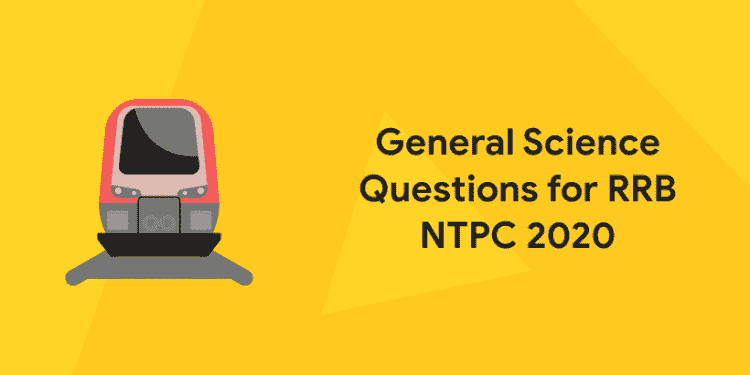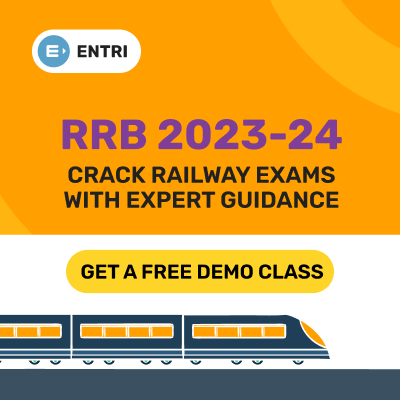General Science is a very important part of various Railway Exams like RRB NTPC, RRB Group D, RRB JE, etc. In this section, basic questions on various sections of the General Science syllabus like Physics, Chemistry, Biology are asked. We will help you in preparation by providing you list of General Science Questions for RRB NTPC 2020.The general Science section of CBT 1 Exam is of 30 Marks and would cover topics from Physics, Chemistry and Life Sciences (up to 10th Standard CBSE syllabus). In this blog we will discuss about General Science Questions for RRB NTPC 2020.
Click here to attempt a free RRB NTPC mock tests to ace your Preparations
List of General Science Questions for RRB NTPC 2020
1. In Human beings the process of digestion of food begins in:
a) Stomach
b) Food Pipe
c) Mouth
d) Small Intestine
Answer: c)
Explanation: Digestion of food starts as soon as we put food in our mouth. The mouth cavity contains teeth, tongue and salivary glands. The teeth cut the food into small pieces, chew and grind it. The teeth help in physical digestion. The salivary glands help in chemical digestion by secreting enzymes.
2. Which of the following organism have parasitic mode of nutrition?
a) Penicillium
b) Plasmodium
c) Paramecium
d) Parrot
Answer: b)
Explanation: In parasitic nutrition organism derives its food from the body of another living organism called host without killing it. Parasitic mode of nutrition is observed in several fungi, bacteria, few plants like Cucuta and some animals like Plasmodium and round worms. Plasmodium causes malarial disease.
3. Name the first enzyme that mix with food in the digestive tract?
a) Pepsin
b) Trypsin
c) Amylase
d) None of the above
Answer: c)
Explanation: The salivary glands present in mouth secrete salivary amylase enzyme which digests the starch present in food into sugar. Digestion of starch or carbohydrate starts in mouth itself. Therefore, amylase is the first enzyme that helps in the process of digestion.
4. Which of the following statement is true about ionic compounds?
- Ionic compounds conduct electricity when dissolved in water.
- Ionic compounds are not soluble in water.
- Ionic compounds are crystalline solids.
Correct options are:
a) Both 1 and 3
b) Both 1 and 2
c) Both 2 and 3
d) All the three
Answer: a)
Explanation: Ionic compounds conduct electricity when dissolved in water or melted. They are soluble in water and are also crystalline solids.
5. The solution of one of the following compounds will conduct electricity. This compound is:
a) CCl4
b) HCl
c) CaCl2
d) CH3Cl
Answer: c)
Explanation: CaCl2 form ionic bond and so will conduct electricity.
Click here to attempt a free RRB NTPC mock tests to ace your Preparations
6. What is an ionic bond?
a) Ionic bond is formed by sharing of electrons between two atoms.
b) It is a bond formed by the transfer of electrons from one atom to another.
c) Both A and B are correct
d) None of the above
Answer: b)
Explanation: Ionic bond is formed by the transfer of electrons from one atom to another.
7. Which mission of NASA brought first human to moon?
a) Apollo program
b) Gemini Program
c) Mercury Program
d) None of the above
Answer: a)
Explanation: Apollo program is NASA mission which brought first human to moon.
8. Name the first Spacecraft to visit the Solar System?
a) Pioneer 10 and Pioneer 11
b) Ranger 1 and Ranger 2
c) Surveyor 6 and Surveyor 7
d) Viking 1 and Viking 2
Answer: a)
Explanation: Pioneer 10 and Pioneer 11 is the first Spacecraft to visit the Solar System.
9. Which of the following in biology is the energy currency of cells?
a) PDP
b) DTP
c) ATP
d) ADP
Answer: c)
Explanation: The process of releasing energy from food is called respiration. The energy is stored in the form of ATP (Adenosine tri phosphate) in the body cells which is used for various purposes like contraction of muscles, conduction of nerve impulses, synthesis of proteins and many other activities related to the functioning of cells. Therefore, ATP is known as the energy currency of cells.
10. In the stem of a plant respiration and breathing takes place through:
a) Lenticels
b) Stomata
c) Root hair
d) Air tubes
Answer: a)
Explanation: In woody stems of plants or trees have lenticels for the exchange of respiratory gases.
11. Which animal has three-chambered heart?
a) Pigeon
b) Lizard
c) Fish
d) Lion
Answer: b)
Explanation: Lizard has three-chambered heart. Except crocodilians all the reptiles have three-chambered heart. Crocodiles have four-chambered heart. Pigeons have four-chambered heart. Fish have two-chambered heart. Lion have four-chambered heart. Birds and mammals have four chambered heart i.e. 2 atria and 2 ventricles. Three-chambered consists of 2 atria and 1 ventricle and two-chambered heart consists of 1 atria and 1 ventricle.
12. Name the ions present in Sodium Oxide compound?
a) Sodium ions
b) Oxide ions
c) Both A and B
d) Neither A nor B
Answer: c)
Explanation: The ions present in Sodium Oxide compound are: Sodium ions and oxide ions.
13. Which of the following are electrovalent compounds?
a) Copper sulphate
b) Calcium nitrate
c) Magnesium oxide
d) All of the above
Answer: d)
Explanation: Electrovalent compound are ionic compounds and so all the options given in the question forms ionic bond.
14. What is the electronic configuration of calcium ion (Ca2+)
a) 2,8
b) 2,8,2
c) 2,8,4
d) 2,8,8
Answer: d)
Explanation: The atomic number of calcium is 20 so its electronic configuration is 2,8,8,2 and so has 2 electrons in the outer most shell. Therefore to form calcium ion (Ca2+), calcium will lose 2 electrons and its configuration becomes 2,8,8.
15. Lunar Eclipse occur:
a) When Sun is between Earth and Moon
b) When Earth is between Sun and Moon
c) When Moon is between Earth and Sun
d) When Earth is between Sun and other celestial bodies
Answer: b)
Explanation: A lunar eclipse occurs when Earth crosses between the moon and the sun, which casts a shadow of Earth onto the moon.
16. Select the correct option matching together about Earth shadows:
- Umbra – darker, central part
- Penumbra – the outer part
- Antumbra – partly shaded area beyond the umbra
Correct Options are:
a) Only 1 and 2
b) Only 2 and 3
c) Only 1
d) All 1, 2 and 3
Answer: d)
Explanation: Shadow of earth is divided into three parts:
Umbra is the innermost and darkest part of the shadow and an observer experiences total eclipse. Penumbra is the region in which only a portion of the light source is blocked by the body. Therefore, an observer experiences partial eclipse. Antumbra is the lighter area of a shadow that appears beyond umbra. An observer experiences annular eclipse.
17. What is Solar Eclipse?
a) When moon comes in between Earth and Sun
b) When Earth comes in between Moon and Sun
c) When Sun comes in between Earth and Moon
d) When Sun rays does not reach Earth.
Answer: a)
Explanation: When the moon orbits Earth, it moves between the sun and Earth. When this happens, the moon blocks the light of the sun from reaching Earth. During a solar eclipse, the moon casts a shadow onto Earth.
18. Transportation of food in plants takes place through:
a) Xylem
b) Phloem
c) Companion cells
d) Tracheids
Answer: b)
Explanation: Plants have two tissues that help in transportation. Xylem transports water and solutes from the roots to the leaves while phloem transports food from the leaves to the rest of the plant.
19. Which salt is used as a raw material for making a large number of useful chemicals in industry?
a) Sodium Chloride
b) Ammonium Hydroxide
c) Ammonium Chloride
d) Sodium Nitrate
Answer: a)
Explanation: Common Salt that is Sodium Chloride is used as a raw material for making a large number of useful chemicals in industry.
20. After wound or cut in a body blood coagulates through:
a) WBC
b) RBC
c) Platelets
d) Plasma
Answer: c)
Explanation: After wound or cut in a body it starts to bleed. But within few seconds or minutes blood cells start to clump together and clot, preventing the further blood loss. These clots are created by a type of blood cell called platelet.
21. Name the salt when on dissolving in water give an acidic solution?
a) Potassium Chloride
b) Ammonium Chloride
c) Sodium Carbonate
d) Sodium Acetate
Answer: b)
Explanation: Ammonium Chloride salt on dissolving in water gives an acidic solution.
22. When the same pattern of solar eclipse repeats every 18 years 11 days 8 hours are known as:
a) Nodes cycle
b) Saros cycle
c) Saras cycle
d) Payan cycle
Answer: b)
Explanation: After one saros cycle of 18 years 11days 8 hours, the pattern of eclipses repeats.
23. Bleaching powder is formed by treating chlorine with…….
a) Calcium Hydroxide
b) Potassium Hydrogen carbonate
c) Magnesium Hydroxide
d) None of the above
Answer: a)
Explanation: Bleaching powder is formed by treating chlorine with calcium Hydroxide.
24. What do you mean by Blood Moon?
a) It is total solar eclipse.
b) It is partial lunar eclipse with red glow
c) It is total lunar eclipse with deep red glow
d) None of the above
Answer: c)
Explanation: A Total Lunar Eclipse can get a deep red glow and is sometimes called a Blood Moon.
25. When blood is forced into the artery, wave like expansion takes place is called:
a) Heart beat
b) Pulse
c) Flow
d) Ticking
Answer: b)
Explanation: The expansion of an artery each time the blood is forced into it is called pulse. The pulse rate of an adult person while resting is 70 to 72 per minute.
Click here to attempt a free RRB NTPC mock tests to ace your Preparations
Why Practice from Entri?
- Always provides you up to date materials that are created by Entri’s Top Experts.
- Mock tests available in bilingual and other regional languages
- Download Entri to access the unlimited mock test.
Navigating through Entri
- Open your Entri App go to the bank Tab and check the mock tests.
- You can check courses and Mock test for other examinations as well
- Subscribe to our Mock Test and clear your examination with flying colors.
Ace your preparation. That is where Entri comes in. It helps you to prepare effectively for your Exam. We hope this blog on General Science Questions for RRB NTPC 2020 has helped you for your preparation.











